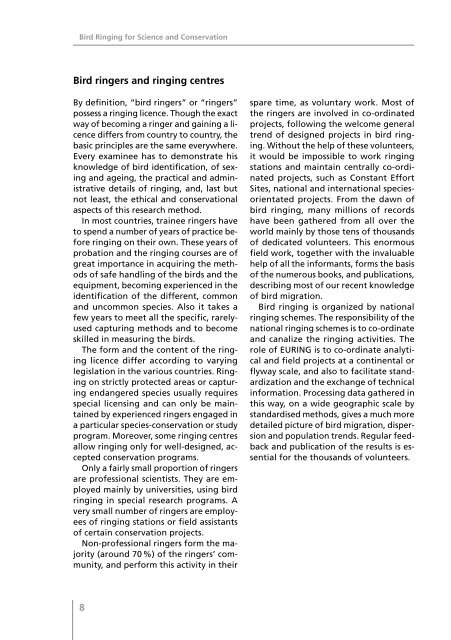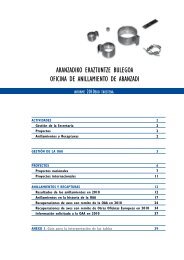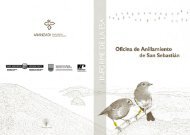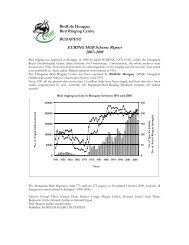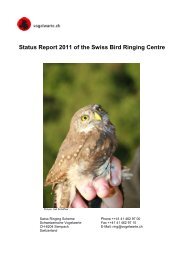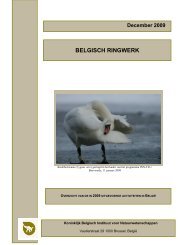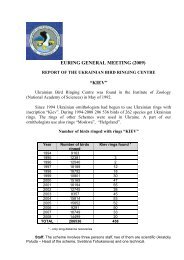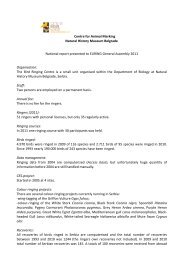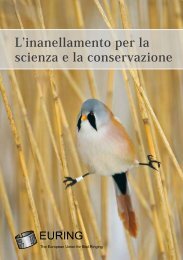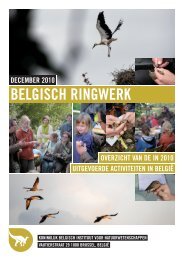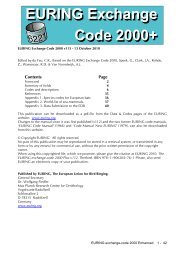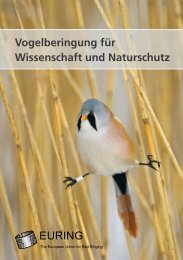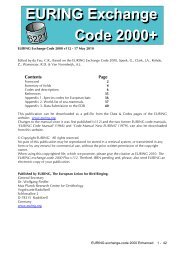Bird Ringing for Science and Conservation - The European Union ...
Bird Ringing for Science and Conservation - The European Union ...
Bird Ringing for Science and Conservation - The European Union ...
- No tags were found...
Create successful ePaper yourself
Turn your PDF publications into a flip-book with our unique Google optimized e-Paper software.
<strong>Bird</strong> <strong>Ringing</strong> <strong>for</strong> <strong>Science</strong> <strong>and</strong> <strong>Conservation</strong><br />
<strong>Bird</strong> <strong>Ringing</strong> <strong>for</strong> <strong>Science</strong> <strong>and</strong> <strong>Conservation</strong><br />
<strong>Bird</strong> ringers <strong>and</strong> ringing centres<br />
EURING<br />
By definition, “bird ringers” or “ringers”<br />
possess a ringing licence. Though the exact<br />
way of becoming a ringer <strong>and</strong> gaining a licence<br />
differs from country to country, the<br />
basic principles are the same everywhere.<br />
Every examinee has to demonstrate his<br />
knowledge of bird identification, of sexing<br />
<strong>and</strong> ageing, the practical <strong>and</strong> administrative<br />
details of ringing, <strong>and</strong>, last but<br />
not least, the ethical <strong>and</strong> conservational<br />
aspects of this research method.<br />
In most countries, trainee ringers have<br />
to spend a number of years of practice be<strong>for</strong>e<br />
ringing on their own. <strong>The</strong>se years of<br />
probation <strong>and</strong> the ringing courses are of<br />
great importance in acquiring the methods<br />
of safe h<strong>and</strong>ling of the birds <strong>and</strong> the<br />
equipment, becoming experienced in the<br />
identification of the different, common<br />
<strong>and</strong> uncommon species. Also it takes a<br />
few years to meet all the specific, rarelyused<br />
capturing methods <strong>and</strong> to become<br />
skilled in measuring the birds.<br />
<strong>The</strong> <strong>for</strong>m <strong>and</strong> the content of the ringing<br />
licence differ according to varying<br />
legislation in the various countries. <strong>Ringing</strong><br />
on strictly protected areas or capturing<br />
endangered species usually requires<br />
special licensing <strong>and</strong> can only be maintained<br />
by experienced ringers engaged in<br />
a particular species-conservation or study<br />
program. Moreover, some ringing centres<br />
allow ringing only <strong>for</strong> well-designed, accepted<br />
conservation programs.<br />
Only a fairly small proportion of ringers<br />
are professional scientists. <strong>The</strong>y are employed<br />
mainly by universities, using bird<br />
ringing in special research programs. A<br />
very small number of ringers are employees<br />
of ringing stations or field assistants<br />
of certain conservation projects.<br />
Non-professional ringers <strong>for</strong>m the majority<br />
(around 70 %) of the ringers’ community,<br />
<strong>and</strong> per<strong>for</strong>m this activity in their<br />
spare time, as voluntary work. Most of<br />
the ringers are involved in co-ordinated<br />
projects, following the welcome general<br />
trend of designed projects in bird ringing.<br />
Without the help of these volunteers,<br />
it would be impossible to work ringing<br />
stations <strong>and</strong> maintain centrally co-ordinated<br />
projects, such as Constant Ef<strong>for</strong>t<br />
Sites, national <strong>and</strong> international speciesorientated<br />
projects. From the dawn of<br />
bird ringing, many millions of records<br />
have been gathered from all over the<br />
world mainly by those tens of thous<strong>and</strong>s<br />
of dedicated volunteers. This enormous<br />
field work, together with the invaluable<br />
help of all the in<strong>for</strong>mants, <strong>for</strong>ms the basis<br />
of the numerous books, <strong>and</strong> publications,<br />
describing most of our recent knowledge<br />
of bird migration.<br />
<strong>Bird</strong> ringing is organized by national<br />
ringing schemes. <strong>The</strong> responsibility of the<br />
national ringing schemes is to co-ordinate<br />
<strong>and</strong> canalize the ringing activities. <strong>The</strong><br />
role of EURING is to co-ordinate analytical<br />
<strong>and</strong> field projects at a continental or<br />
flyway scale, <strong>and</strong> also to facilitate st<strong>and</strong>ardization<br />
<strong>and</strong> the exchange of technical<br />
in<strong>for</strong>mation. Processing data gathered in<br />
this way, on a wide geographic scale by<br />
st<strong>and</strong>ardised methods, gives a much more<br />
detailed picture of bird migration, dispersion<br />
<strong>and</strong> population trends. Regular feedback<br />
<strong>and</strong> publication of the results is essential<br />
<strong>for</strong> the thous<strong>and</strong>s of volunteers.<br />
12 000<br />
50<br />
15 000<br />
133<br />
8 000<br />
20<br />
200 000<br />
400<br />
240 000<br />
350<br />
70 000<br />
175<br />
880000<br />
2100 350000<br />
830<br />
380 000<br />
762<br />
220000<br />
460<br />
700000<br />
374<br />
90 000<br />
230<br />
200 000<br />
400<br />
150 000<br />
450<br />
50000<br />
50<br />
38000<br />
40<br />
315 000<br />
250<br />
27 000<br />
52<br />
180 000<br />
260<br />
12 000<br />
20<br />
50 000<br />
200<br />
12 000<br />
46<br />
220 000<br />
700<br />
15000<br />
200<br />
90000<br />
50<br />
6500<br />
35<br />
15 000<br />
450<br />
15 000<br />
7<br />
<strong>The</strong> numbers of birds ringed annually <strong>and</strong> the numbers of ringers licensed by each<br />
ringing centre. If several ringing centres operate in one state, summary figures are<br />
given. It is estimated that 115 million birds have been ringed in Europe during the<br />
20th century <strong>and</strong> the number of recoveries now exceed 2 million.<br />
1 000<br />
10<br />
110 000<br />
90<br />
5 500<br />
60<br />
25 000<br />
250 000<br />
70 groups<br />
8<br />
9


